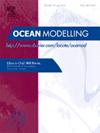吕宋海峡附近南海潮汐对涡动粘度的影响
IF 2.9
3区 地球科学
Q2 METEOROLOGY & ATMOSPHERIC SCIENCES
引用次数: 0
摘要
非局域K廓线参数化(KPP)是水柱中垂直湍流混合的一维参数化。它是混合坐标海洋模型(HYCOM)中使用的主要混合方案。在KPP中有两种不同的混合机制。在海洋表面边界层(OSBL)中,混合是由表面强迫驱动的。在海洋内部,垂直混合由分解剪切不稳定、内波背景和双扩散混合驱动。在本研究中,利用两个全球HYCOM模拟,在有潮汐强迫和没有潮汐强迫的情况下,研究了2019年潮汐对吕宋海峡附近南海涡旋粘度的影响。我们的分析表明,潮汐在改变涡流粘度方面起着至关重要的作用。吕宋海峡内潮在潮汐强迫条件下向南海传播。它们增加了速度的垂直切变,从而增强了海洋内部的涡旋粘度。值得注意的是,带潮汐的HYCOM模拟显示了大量的涡动粘度,在20.3°N以北吕宋海峡约2000 m的深度达到10−3 m2s−1数量级。海洋内部强涡旋黏度的大潮-小潮循环特征明显,其产生是由内潮引起的。由于南海上层海洋(~ 100 m)存在高盐度的北太平洋热带水,盐指法产生的双重扩散混合比这些深度的背景内波贡献更重要。2019年夏季和冬季,潮汐还增强了吕宋海峡的净向下表面热通量,降低了表面应力。但2019年6月(12月)潮汐主要使吕宋海峡OSBL深度减小(加深),并主要导致2019年6月(12月)OSBL涡动粘度减小(增加)。本文章由计算机程序翻译,如有差异,请以英文原文为准。
The effect of tides on eddy viscosity via K-profile parameterization in the South China Sea near Luzon Strait
The non-local K Profile Parameterization (KPP) is a one-dimensional parameterization of the vertical turbulence mixing in the water column. It is the main mixing scheme used in the HYbrid Coordinate Ocean Model (HYCOM). There are two distinct mixing regimes in KPP. In the ocean surface boundary layer (OSBL), the mixing is driven by surface forcing. In the ocean interior, vertical mixing is driven by resolved shear instability, internal wave background, and double diffusive mixing. In this research, two global HYCOM simulations conducted with and without tidal forcing are used to study how tides affect eddy viscosity in the South China Sea (SCS) near Luzon Strait in 2019. Our analysis reveals that tides play a crucial role in modifying eddy viscosity. Internal tides generated at Luzon Strait propagate into the SCS under tidal forcing conditions. They increase the vertical shear of the velocity and consequently enhance eddy viscosity in the ocean interior. Notably, the HYCOM simulation with tides demonstrates substantial eddy viscosity, reaching the order of 10−3 m2s−1 at a depth of ∼2000 m at the Luzon Strait to the north of 20.3°N. The clear signature of spring-neap tidal cycle in the strong eddy viscosities in the ocean interior attribute their generation to internal tides. Due to the existence of the high-salinity North Pacific Tropical Water in the upper ocean of SCS (∼100 m), double diffusive mixing generated by salt fingering is shown to be more important than the background internal wave contribution at these depths. Tides also enhance the net downward surface heat flux and reduce the surface stress at Luzon Strait in both summer and winter of 2019. But tides mainly reduce (deepen) the OSBL depth at Luzon Strait in June (December) 2019 and lead mainly to a reduction (increase) of eddy viscosity in the OSBL in June (December) 2019.
求助全文
通过发布文献求助,成功后即可免费获取论文全文。
去求助
来源期刊

Ocean Modelling
地学-海洋学
CiteScore
5.50
自引率
9.40%
发文量
86
审稿时长
19.6 weeks
期刊介绍:
The main objective of Ocean Modelling is to provide rapid communication between those interested in ocean modelling, whether through direct observation, or through analytical, numerical or laboratory models, and including interactions between physical and biogeochemical or biological phenomena. Because of the intimate links between ocean and atmosphere, involvement of scientists interested in influences of either medium on the other is welcome. The journal has a wide scope and includes ocean-atmosphere interaction in various forms as well as pure ocean results. In addition to primary peer-reviewed papers, the journal provides review papers, preliminary communications, and discussions.
 求助内容:
求助内容: 应助结果提醒方式:
应助结果提醒方式:


